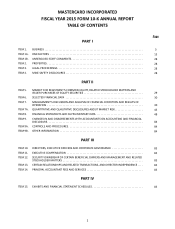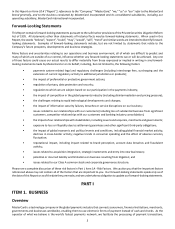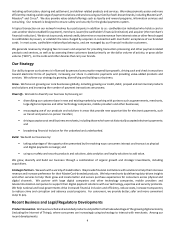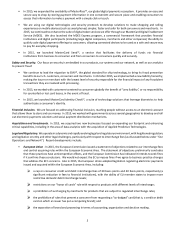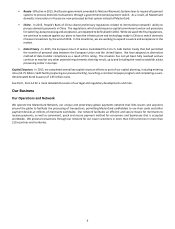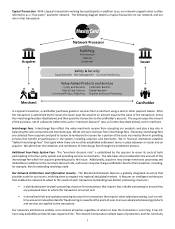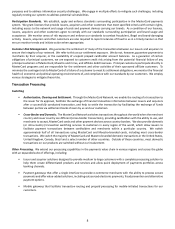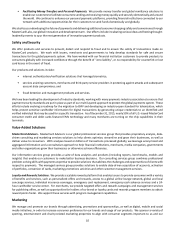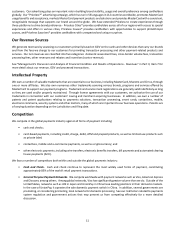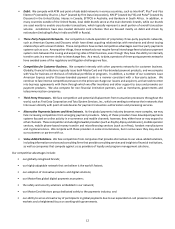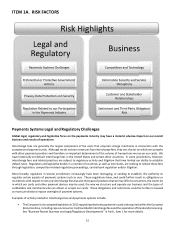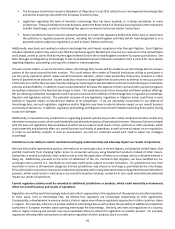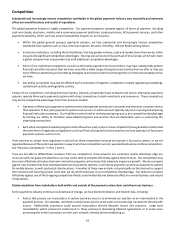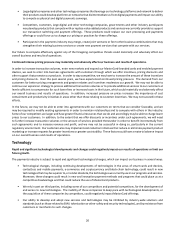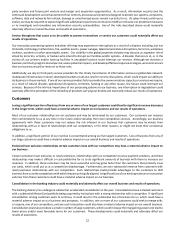MasterCard 2015 Annual Report Download - page 18
Download and view the complete annual report
Please find page 18 of the 2015 MasterCard annual report below. You can navigate through the pages in the report by either clicking on the pages listed below, or by using the keyword search tool below to find specific information within the annual report.12
• Debit. We compete with ATM and point-of-sale debit networks in various countries, such as Interlink®, Plus® and Visa
Electron® (owned by Visa Inc.), Star® (owned by First Data Corporation), NYCE® (owned by FIS) and Pulse® (owned by
Discover) in the United States; Interac in Canada; EFTPOS in Australia; and Bankserv in South Africa. In addition, in
many countries outside of the United States, local debit brands serve as the main domestic brands, while our brands
are used mostly to enable cross-border transactions, which typically represent a small portion of overall transaction
volume. Jurisdictions have also created domestic card schemes that are focused mostly on debit and driven by
nationalism (including RuPay in India and MIR in Russia).
• Three-Party Payments Networks. Our competitors include operators of proprietary three-party payments networks,
such as American Express and Discover, which have direct acquiring relationships with merchants and direct issuing
relationships with account holders. These competitors have certain competitive advantages over four-party payments
systems such as ours. Among other things, these networks do not require formal interchange fees to balance payment
system costs between the issuing and acquiring sides of their business, even though they have the ability to internally
transfer costs in a manner similar to interchange fees. As a result, to date, operators of three-party payments networks
have avoided some of the regulatory and litigation challenges we face.
• Competition for Customer Business. We compete intensely with other payments networks for customer business.
Globally, financial institutions typically issue both MasterCard and Visa-branded payment products, and we compete
with Visa for business on the basis of individual portfolios or programs. In addition, a number of our customers issue
American Express and/or Discover-branded payment cards in a manner consistent with a four-party system. We
continue to face intense competitive pressure on the prices we charge our issuers and acquirers, and we seek to enter
into business agreements with them through which we offer incentives and other support to issue and promote our
payment products. We also compete for non-financial institution partners, such as merchants, governments and
telecommunication companies.
• Third-Party Processors. We face competition and potential displacement from transaction processors throughout the
world, such as First Data Corporation and Total System Services, Inc., which are seeking to enhance their networks that
link issuers directly with point-of-sale devices for payment transaction authorization and processing services.
• Alternative Payments Systems and New Entrants. As the global payments industry becomes more complex, we may
face increasing competition from emerging payment providers. Many of these providers have developed payments
systems focused on online activity in e-commerce and mobile channels; however, they either have or may expand to
other channels. These competitors include digital wallet providers (such as PayPal, Alipay and Amazon), mobile operator
services, mobile phone-based money transfer and microfinancing services (such as mPesa), handset manufacturers
and cryptocurrencies. We compete with these providers in some circumstances, but in some cases they may also be
our customers or partner with us.
• Value-Added Solutions. We face competition from companies that provide alternatives to our value-added solutions,
including information services and consulting firms that provide consulting services and insights to financial institutions,
as well as companies that compete against us as providers of loyalty and program management solutions.
Our competitive advantages include:
• our globally recognized brands;
• our highly adaptable network that we believe is the world’s fastest;
• our adoption of innovative products and digital solutions;
• our MasterPass global digital payments ecosystem;
• the safety and security solutions embedded in our network;
• our MasterCard Advisors group dedicated solely to the payments industry; and
• our ability to serve a broad array of participants in global payments due to our expanded on-soil presence in individual
markets and a heightened focus on working with governments.


